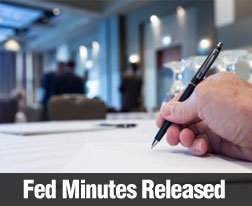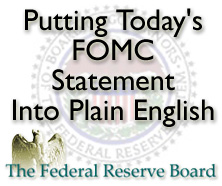FOMC Minutes: Housing Market Stable But Slow
 The minutes of the March meeting of the Fed’s Federal Open Market Committee (FOMC) were released Tuesday and included a staff review of current economic conditions. The minutes noted that while labor markets continued to grow, inflation to the Fed’s target rate of 2.00 percent was impeded by dropping fuel prices. The Committee noted that expectations for longer-term inflation remained stable.
The minutes of the March meeting of the Fed’s Federal Open Market Committee (FOMC) were released Tuesday and included a staff review of current economic conditions. The minutes noted that while labor markets continued to grow, inflation to the Fed’s target rate of 2.00 percent was impeded by dropping fuel prices. The Committee noted that expectations for longer-term inflation remained stable.
Non-farm payrolls, which include both private and public sector jobs, grew in January and February and the national unemployment rate reached a new low of 5.50 percent in February. Readings for workers employed part time due to economic reasons edged down and workforce participation was up.
These developments are noteworthy as in recent months analysts have repeatedly cited concerns over the numbers of workers who have stopped looking for work and those who work part time because they cannot find full-time employment. Meeting participants said that underutilization of labor resources “continued to diminish,” but also said that levels for those involuntarily working part-time and still elevated numbers of workers no longer seeking employment.
Personal consumption expenditures slowed in the first quarter due to falling fuel prices and winter weather conditions. Households had more disposable income and household wealth increased due to increasing home values. The Committee said that consumer sentiment was near pre-recession levels according to the University of Michigan’s consumer sentiment survey.
Fed Says Housing Activity “Slow,” No Decision on Raising Fed Funds Rate
The FOMC minutes reflect the committee’s view that housing markets are performing at a slower rate than other economic sectors. The minutes said that building permits and housing starts for single family homes were lower in January and February. Sales of new and existing homes were down in January, but pending home sales rose. This suggests that while markets slowed (as they typically do) during winter, pending sales suggest that completed sales will recover in the late winter and early spring.
The FOMC minutes noted that mortgage credit remained challenging for those in the lower portion of the credit score distribution, but said that the cost of mortgages was historically low for those who qualified for home loans.
The Committee also addressed the likelihood of raising the Federal Funds rate in its usual non-definitive manner. While raising the rate at the next meeting seemed unlikely, committee members wanted the flexibility to raise the target federal funds rate when conditions warrant. The target rate is currently set at 0.00 to 0.25 percent; when the FOMC moves to raise the target federal funds rate, the cost of credit including mortgage loans can be expected to increase.
 Last week’s events included the National Association of Home Builder’s Housing Market Index, which fell to its lowest reading since last summer. Other news included reports on housing starts and building permits, the FOMC meeting statement and Fed Chair Janet Yellen’s press conference.
Last week’s events included the National Association of Home Builder’s Housing Market Index, which fell to its lowest reading since last summer. Other news included reports on housing starts and building permits, the FOMC meeting statement and Fed Chair Janet Yellen’s press conference. The post-meeting statement of the Federal Reserve’s Federal Open Market Committee indicated that while the Federal Reserve is considering raising its target rate as early as June, the agency is in no hurry to cast anything in cement. The statement cited stronger labor markets and low unemployment rates as encouraging, but noted that FOMC members remain concerned about economic growth due to low inflation failing to meet the FOMC goal of two percent.
The post-meeting statement of the Federal Reserve’s Federal Open Market Committee indicated that while the Federal Reserve is considering raising its target rate as early as June, the agency is in no hurry to cast anything in cement. The statement cited stronger labor markets and low unemployment rates as encouraging, but noted that FOMC members remain concerned about economic growth due to low inflation failing to meet the FOMC goal of two percent.